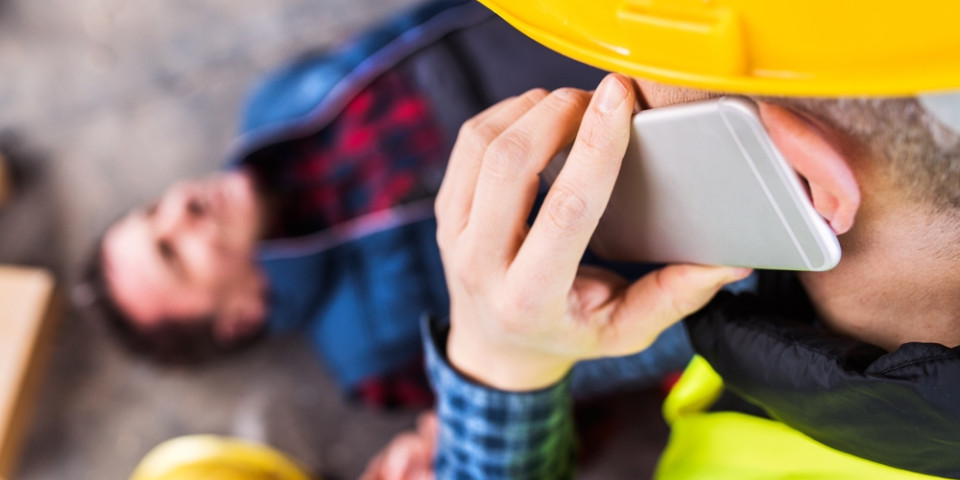Latest News
Construction Site First Aid Training: When Seconds Count, Confidence Saves Lives
Posted on Wednesday, 5th November 2025

When an accident happens on a construction site, there’s no time to hesitate.
Whether it’s a fall from height, a crush injury, or sudden cardiac arrest, those first few minutes before paramedics arrive are critical, and your team’s response can make all the difference.
According to HSE’s latest figures, an estimated 604,000 UK workers sustained a non-fatal workplace injury in 2023/24, with the construction sector accounting for a significant share — around 47,000 cases each year on average.
Here are five real emergencies every site worker should be ready for, and how first aid training gives you the skills to protect your team when it matters most.
1. Fall from Height
Working at height remains one of the biggest causes of fatal and major injuries in construction. Even a short fall can cause fractures, spinal injuries, or internal bleeding.
What to do:
- Keep the casualty still and calm, never move them unless they’re in immediate danger.
- Check for breathing and consciousness.
- Call 999 immediately and monitor vital signs until help arrives.
- If they’re bleeding, apply gentle pressure with a clean pad or cloth without changing their position.
Can anyone do this?
Anyone can call for help, reassure the casualty, and avoid unnecessary movement, but assessing breathing safely or recognising signs of shock requires proper training.
Why first aid training helps:
Knowing how to manage shock and immobilise potential fractures can dramatically reduce the severity of injuries while waiting for emergency services.
Falls remain one of the leading causes of serious injuries. Find out how our Working at Height courses can help you prevent them.
2. Heavy Bleeding from Power Tools
Cuts from saws, grinders, or drills are common on busy sites, and serious bleeding can become life-threatening in minutes.
What to do:
- Apply firm, direct pressure to the wound.
- Use a bandage or clean cloth to maintain pressure.
- If blood soaks through, add more material on top rather than removing the original pad.
- Raise the injured limb if possible.
Can anyone do this?
Yes — anyone can apply pressure with a clean cloth while waiting for trained help. However, untrained responders may not recognise the signs of catastrophic bleeding or know how to maintain pressure correctly for extended periods.
Why first aid training helps:
First aiders learn how to control severe bleeding, apply bandages correctly, and use improvised dressings safely, vital skills when professional help is still on its way.
3. Crush Injury
Crush injuries can happen when a worker becomes trapped by collapsing materials, moving vehicles, or heavy equipment. These are serious and can cause internal bleeding, fractures, and even cardiac arrest.
What to do:
- Do not remove the crushing force unless it’s safe and you’re trained to do so.
- Call 999 immediately.
- If the person is unconscious but breathing, place them in the recovery position (if safe).
- Be ready to perform CPR if they stop breathing.
Can anyone do this?
Most people can make the 999 call and ensure the area is safe, but performing CPR, placing someone in the recovery position correctly, or managing airway issues all require first aid training and practice.
Why first aid training helps:
Understanding the dangers of crush syndrome and how to manage airways, shock, and resuscitation can make the difference between life and death.
4. Electrical Shock
Construction sites are full of potential electrical hazards, from faulty tools to exposed wiring. Electric shocks can cause burns, heart rhythm disturbances, and respiratory arrest.
What to do:
- Do not touch the casualty until the power source is switched off.
- Once safe, check for responsiveness and breathing.
- Be prepared to start CPR if necessary.
- Treat visible burns with cool running water for at least 10 minutes.
Can anyone do this?
Anyone can ensure the power is off and call for help, but recognising the difference between minor and major burns or safely starting CPR are skills learned through proper training.
Why first aid training helps:
A trained first aider knows how to assess burns, perform CPR safely, and manage airway complications after electric shock.
5. Cardiac Arrest
Cardiac arrests can happen to anyone, at any age, including healthy workers under stress or extreme temperatures. Without quick intervention, survival rates drop by 10% every minute.
What to do:
- Call 999 immediately and start CPR.
- Use a defibrillator (AED) if available — many sites now keep one on-site.
- Follow the voice instructions until help arrives.
Can anyone do this?
Yes — anyone can use an AED by following its spoken instructions, but the confidence to perform CPR effectively under pressure only comes with training.
Why first aid training helps:
First aiders are trained to act fast and with confidence, using CPR and AEDs effectively, giving casualties the best possible chance of survival.
Why First Aid Training Matters on Every Construction Site
Every site should have enough trained first aiders to deal with these emergencies confidently.
First aid knowledge builds a culture of safety, strengthens compliance with HSE regulations, and most importantly, saves lives.
At Essential Site Skills, our First Aid at Work Course and Emergency First Aid at Work courses give workers the confidence to respond in real-world emergencies, whether that’s on-site or off.
Be Ready When It Matters Most
Ensure your workforce can act fast in an emergency.
Explore our accredited first aid courses and book your place today:


